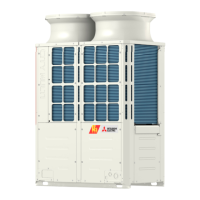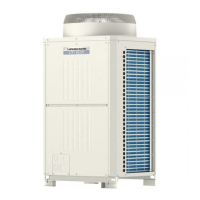What to do if my Mitsubishi Electric PURY-P400YGM-A Air Conditioner has a drain pump abnormality?
- PPamela CastroAug 28, 2025
If your Mitsubishi Electric Air Conditioner is showing a drain pump abnormality, check Code List 2502.

What to do if my Mitsubishi Electric PURY-P400YGM-A Air Conditioner has a drain pump abnormality?
If your Mitsubishi Electric Air Conditioner is showing a drain pump abnormality, check Code List 2502.
What to do if my Mitsubishi Electric Air Conditioner displays a thermal sensor abnormality?
If your Mitsubishi Electric Air Conditioner shows a thermal sensor abnormality, check Code List 5101.
What to do if my Mitsubishi Electric Air Conditioner shows fan speed abnormality (motor abnormality) (IC, LC)?
If you're encountering a fan speed abnormality (motor abnormality) (IC, LC) with your Mitsubishi Electric Air Conditioner, check Code List 4116.
What to do if my Mitsubishi Electric PURY-P400YGM-A is leaking water (LC)?
If you are experiencing water leakage (LC) with your Mitsubishi Electric Air Conditioner, check Code List 2600.
What to do if my Mitsubishi Electric Air Conditioner has a water leakage abnormality?
If you notice a water leakage abnormality with your Mitsubishi Electric Air Conditioner, check Code List 2500.
| Series | PURY |
|---|---|
| Refrigerant | R410A |
| Power Supply | 380-415V, 50Hz |
| Operating Temperature (Cooling) | -5°C to 46°C |
| Operating Temperature (Heating) | -15°C to 24°C |
Defines warning and caution symbols used in the text of the manual.
Defines symbols used in illustrations to indicate actions, important instructions, grounding, and electric shock warnings.
Lists essential checks before commencing servicing operations.
Details the tools and materials required for installation and servicing.
Specifies the types of copper pipes and their radial thickness requirements.
Provides guidelines on proper storage locations and sealing of piping materials.
Explains the use of ester oil, ether oil, or alkylbenzene for flares and flange connections.
Outlines brazing procedures and precautions, emphasizing non-oxide brazing.
Describes the procedure for pressurizing equipment with nitrogen and investigating leakage.
Details the vacuum pump requirements, degree of vacuum, and evacuation time.
Explains vacuum pump with reverse-flow check valve and special vacuum drying procedures.
Specifies that R410A must be in a liquid state when charging.
Provides guidance on additional refrigerant charging in case of leaks.
Compares chemical properties, composition, and pressure characteristics of refrigerants.
Details refrigerating machine oil types and the effects of contaminants in the system.
Provides attention points for electrical work and M-NET control wiring.
Explains switch settings and address assignments for various units and controllers.
Illustrates various system connection configurations for remote controllers.
Shows front and rear views of the unit, identifying key components and refrigerant circuit parts.
Illustrates the appearance and internal circuit boards of the control box.
Provides detailed views of the main board and INV board with component labels.
Shows front and rear views of BC controllers, identifying components and connections.
Illustrates the BC controller control box and its components.
Provides a detailed view of the BC controller board with labeled components.
Compares functions and specifications of MA and M-NET remote controllers.
Explains group setting and interlocking registration procedures for ME remote controllers.
Details the procedure for interlocking Lossnay units with MA remote controllers.
Explains how to switch to the built-in thermo function on the remote controller.
Presents the electrical wiring diagram for specific PURY model series.
Provides the electrical wiring diagram for higher capacity PURY model series.
Shows the electrical wiring diagram for the CMB-P104V-G BC controller.
Illustrates the electrical wiring diagram for CMB-P105 and 106V-G units.
Details the electrical wiring diagram for CMB-P108 and 1010V-G units.
Provides the electrical wiring diagram for CMB-P1013 and 1016V-G units.
Shows the electrical wiring diagram for the CMB-P104V-GB BC controller.
Illustrates the electrical wiring diagram for CMB-P108V-GB BC controller.
Details the electrical wiring diagram for CMB-P108 and 1010V-GA units.
Provides the electrical wiring diagram for CMB-P1013 and 1016V-GA units.
Presents simplified diagrams of the refrigerant circuit for different unit types.
Explains the functions, specifications, and check methods for key components.
Details dip switch functions and their factory settings for outdoor units and boards.
Explains initial control, start-up control, bypass, frequency, and defrost operations.
Describes control logic for solenoid valves (SVA, SVB, SVC) and compressors (SVM1, SVM2).
Explains how cooling/heating operations can be prohibited via external input.
Provides flowcharts for determining indoor and outdoor unit operation modes.
Lists critical checks before initiating a test run, including refrigerant leaks and power supply.
Details the procedure for performing a test run using the remote controller.
Explains refrigerant amount's impact on operating characteristics and accumulator levels.
Provides symptoms and methods for judging and adjusting refrigerant amounts.
Describes the procedure for entering refrigerant volume adjustment mode.
Lists common symptoms that are not indicative of actual problems.
Provides standard operating data for cooling operation across various models.
Lists error codes, their meanings, and detection methods.
Details mechanical and communication/system errors and their troubleshooting steps.
Covers errors related to IPM, ACCT, and DCCT sensors and circuits.
Addresses errors related to communication and system setup.
Describes the cause and countermeasures for a no-response communication error.
Details system errors like total capacity, capacity code, and connection number issues.
Explains issues when the total capacity of connected indoor units exceeds limits.
Covers errors related to incorrect indoor unit model or switch settings.
Addresses issues when the number of connected units exceeds system limitations.
Details erroneous settings for outdoor unit and BC controller addresses.
Explains errors related to incorrect branch port numbering or setting.
Covers issues with transmission booster or power supply for transmission lines.
Addresses errors where the remote controller does not receive temperature data.
Details errors related to disconnection of plugs on the main board.
Covers errors related to incorrect model-switching switch settings.
Addresses errors when refrigerant pipes have not been washed.
Explains errors when units with different refrigerant systems are connected.
Guides troubleshooting for MA and M-NET remote controller malfunctions.
Troubleshooting steps for MA remote controller issues.
Troubleshooting steps for M-NET remote controller issues.
Troubleshooting for combined MA and M-NET remote controller systems.
Details methods for investigating transmission wave shape and noise issues.
Explains symptoms and methods for confirming wave shape in M-NET transmission.
Provides measures against noise and checks for transmission line issues.
Covers troubleshooting for key components like sensors and valves.
Details troubleshooting procedures for high and low-pressure sensors.
Explains the low-pressure sensor configuration and troubleshooting steps.
Provides troubleshooting methods for solenoid valves (SV1-SV5).
Outlines checks for fan revolution, speed, and abnormal operation.
Provides troubleshooting methods for BC controller parts like sensors and LEV.
Details troubleshooting flowcharts for pressure sensors (PS1, PS3).
Provides troubleshooting steps for temperature sensors (TH series).
Guides troubleshooting for LEV and solenoid valve operations.
Provides step-by-step instructions for replacing the compressor.
Details the procedure for collecting cooling liquid from the accumulator.
Provides service instructions for BC controller parts like panels, boxes, and sensors.
Instructions for removing the service panel.
Instructions for checking and replacing the control box components.
Details procedures for checking and replacing thermistors.
Provides steps for removing and replacing pressure sensors.
Instructions for removing and replacing LEV components.
Details procedures for removing and replacing solenoid valves.
Explains how to read LED monitor displays for service.
Describes the model information displayed during initial setting.
Explains the outdoor unit's clock function and saving error history data.
Provides a comprehensive list of LED codes and their corresponding items.











